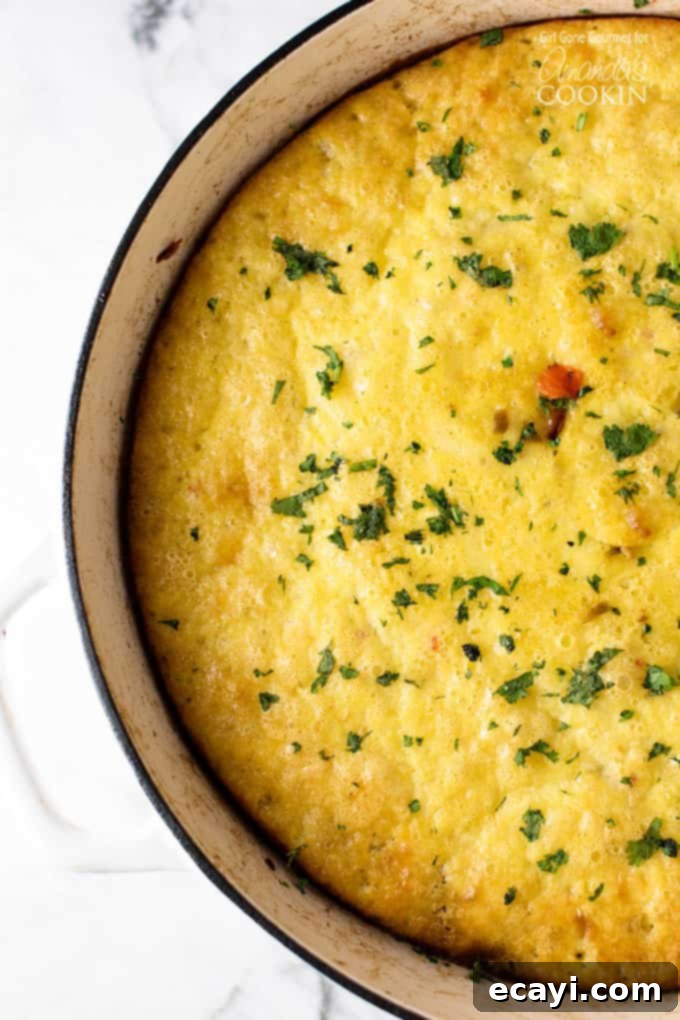Ultimate Fluffy Vegetable Frittata: Your Perfect Breakfast & Brunch Dish
Prepare to elevate your breakfast and brunch game with this incredibly light and irresistibly fluffy Vegetable Frittata. This recipe isn’t just another egg dish; it’s a vibrant symphony of flavors and textures, packed with hearty potatoes, colorful bell peppers, a hint of spice from poblano pepper, creamy ricotta cheese, and savory Monterey Jack. Whether you’re planning a leisurely weekend breakfast, a casual lunch, or an elegant brunch gathering, this frittata is designed to be the undisputed star. Get ready to discover the simple secret that transforms an ordinary frittata into an extraordinary, towering masterpiece that will impress everyone at your table.

Why This Fluffy Vegetable Frittata Will Become Your Favorite
For years, many home cooks, myself included, have strived to achieve that perfect, airy frittata – one that rises beautifully without collapsing, maintaining a delicate yet satisfying texture. This quest often led to experimenting with different egg-to-dairy ratios, cooking methods, and pan types. But the real game-changer, the secret ingredient that truly sets this frittata apart, came from an unexpected source of inspiration: the Barefoot Contessa herself, Ina Garten. Her philosophy of simple, elegant, and unfailingly delicious cooking has always resonated, reminding us that the best meals are made with care and, indeed, love. It was through adapting her brilliant technique that I created this vegetarian version, equally delightful and perfect for any meal of the day.
The secret to a dramatically tall and incredibly fluffy frittata lies in the subtle addition of a small amount of **all-purpose flour and baking soda** to the egg mixture. This humble combination provides the structural integrity and leavening power that eggs alone often lack, preventing your frittata from turning out flat or dense. Instead, it bakes up into a puffed, golden-brown cloud of savory goodness, making every bite a delightful experience. This simple trick ensures your frittata consistently achieves its full, delicious potential, proving that sometimes the smallest tweaks lead to the biggest culinary triumphs.
Understanding the Magic: The Science Behind a Truly Fluffy Frittata
You might be wondering, “Why add flour and baking soda to eggs?” It’s an excellent question, and the answer lies in fundamental baking science. While eggs are naturally light and airy when whisked, they can lose significant volume during baking, especially when combined with the weight of vegetables and cheese in a frittata. The small amount of all-purpose flour acts as a gentle binder, providing a light structure for the egg mixture to cling to, preventing it from becoming overly fragile or watery. Simultaneously, baking soda, when reacting with the slight acidity present in the eggs and other ingredients, creates tiny carbon dioxide gas bubbles. As the frittata heats in the oven, these bubbles expand, gently lifting the entire mixture and resulting in that wonderfully light, airy, and consistently fluffy texture we all desire.
This method doesn’t just make the frittata taller; it transforms its entire eating experience. It transitions from a simple skillet dish into a more substantial, almost soufflé-like creation. It holds its shape beautifully, allows for clean, effortless slices, and offers a stunning visual appeal that is perfect for entertaining guests or simply indulging in a luxurious meal at home. It’s a testament to how small, intelligent additions can make a monumental difference in the outcome of a dish, elevating it from merely good to truly gourmet and memorable.

Key Ingredients for an Exceptional Vegetable Frittata
Crafting the perfect frittata begins with selecting quality ingredients that contribute to both flavor and texture. Here’s a closer look at what makes this recipe sing:
- Yukon Gold Potatoes: We specifically choose Yukon Gold potatoes for their superior creamy texture and remarkable ability to maintain their shape beautifully when cooked. Unlike starchier varieties that might crumble or become mushy, Yukon Golds offer a delightful bite. Giving them a brief head start in the pan ensures they are tender and perfectly cooked through, adding a satisfying heartiness to every slice.
- Flavorful Peppers & Onion: This frittata boasts a vibrant medley of red onion, sweet red bell pepper, and a subtle kick from poblano pepper, creating a dynamic and well-rounded flavor base. The red onion provides a sharp, aromatic sweetness, while the red bell pepper contributes a juicy crunch and mild sweetness. The poblano pepper introduces a gentle, earthy heat without overwhelming the other flavors, making it palatable for all tastes. Sautéing them until softened brings out their natural sugars and deepens their savory notes.
- The Magical Egg Mixture: Our foundation consists of eight large eggs, providing a rich flavor and essential protein. The real magic happens with the addition of ⅓ cup of all-purpose flour and 1 teaspoon of baking soda. These are meticulously whisked into the eggs, working together to create that desired lift and a sturdy yet wonderfully tender structure for your frittata. This trio ensures a light, airy result every time.
- The Irresistible Cheese Duo: This frittata features two distinct cheeses, carefully chosen for their complementary textures and flavor profiles. Creamy ricotta cheese melts seamlessly into the egg mixture, imparting a luscious, moist consistency and a delicate, milky flavor that balances the other ingredients. Grated Monterey Jack cheese adds a fantastic savory depth, a touch of tang, and a wonderful Southwestern-inspired zest, making each bite incredibly satisfying and flavorful.
- Fresh Garnish: A final sprinkling of freshly chopped parsley not only adds a vibrant pop of green color but also a fresh, herbaceous note that brightens the entire dish. This simple garnish provides a lovely contrast to the rich eggs and cheeses, elevating the overall presentation and taste.
Essential Kitchen Tools for Frittata Success
Having the right tools on hand can make the cooking process smoother, more efficient, and ultimately more enjoyable. For preparing this delicious fluffy vegetable frittata, these are some of our top recommendations:
- Chef’s Knife: A sharp, high-quality chef’s knife is an invaluable tool for efficiently dicing potatoes, onions, and peppers. Uniform cuts are key to ensuring all vegetables cook evenly, contributing to a perfectly textured frittata.
- 10-inch Round Oven-Safe Skillet: This is perhaps the most crucial tool for a frittata, as the dish starts on the stovetop and finishes baking in the oven. An oven-safe skillet (such as cast iron or stainless steel) that measures 10 inches in diameter is ideal for this recipe, allowing the frittata to achieve the perfect thickness and generous servings.
- Measuring Cups & Spoons: For consistent and reliable results, accurate measurements of ingredients like flour, baking soda, salt, and pepper are vital. A good set of measuring cups and spoons will ensure your frittata always turns out perfectly balanced in flavor and texture.
- Whisk: A sturdy whisk is essential for thoroughly combining the eggs, flour, baking soda, and cheeses into a smooth, airy mixture. Proper whisking is a key step in incorporating air and activating the leavening agents, which directly contributes to the fluffy texture of the finished frittata.
This recipe provides a fantastic alternative to classic breakfast casseroles and is wonderfully adaptable. If you’re a fan of heartier frittatas, you might also adore my Cheesy Bacon Potato Frittata, which offers a different but equally comforting profile with its rich bacon and extra cheese.

Tips for Making Your Fluffy Vegetable Frittata Absolutely Perfect
Achieving a consistently perfect frittata is simple when you keep a few key considerations in mind. These tips will help ensure your vegetable frittata is always a success:
- Avoid Overcooking: A common pitfall in frittata making is overbaking, which can lead to a dry, rubbery texture. Keep a close eye on your frittata as it bakes. Remove it from the oven as soon as a toothpick or knife inserted into the center comes out clean. The edges should be beautifully set and lightly golden brown, while the very center might still have a slight jiggle, which will firm up perfectly as it cools.
- Ensure Evenly Cooked Vegetables: The texture of your vegetables significantly impacts the overall frittata. It’s important to cook your potatoes and peppers until they are tender but still retain a slight crispness, avoiding any mushiness. The initial cooking of the potatoes is particularly crucial to ensure they are fully cooked through before the egg mixture is added.
- Choose the Right Pan: A good quality, oven-safe, non-stick skillet is your best friend for this recipe. Cast iron or heavy-bottomed stainless steel skillets work wonderfully, allowing for easy transfer from stovetop to oven and preventing any sticking. Make sure your pan is well-seasoned or adequately greased before you begin cooking.
- Embrace Customization: While this recipe is incredibly flavorful as written, frittatas are wonderfully forgiving and versatile. Feel free to experiment with other vegetables that you love, such as fresh spinach, sliced mushrooms, zucchini, tender asparagus, or vibrant cherry tomatoes. You can also swap out the cheeses for other favorites like sharp cheddar, creamy Gruyère, or a spicy pepper jack for an extra kick.
- Serving Temperature Versatility: One of the best qualities of a frittata is its versatility in serving temperature. It is absolutely delicious both warm, straight from the oven, or cooled to room temperature. This makes it an excellent choice for meal prepping, taking to potlucks, or packing for a sophisticated picnic.
- Proper Cooling Before Slicing: Allow your frittata to rest for at least 5-10 minutes after removing it from the oven. This brief resting period allows the eggs to fully set and the internal heat to redistribute, ensuring cleaner slices and preventing it from falling apart when served.
Frequently Asked Questions About Frittatas
- What is the main difference between a frittata, an omelet, and a quiche?
- A frittata is an Italian egg dish that is typically started on the stovetop in an oven-safe skillet and then finished by baking in the oven. Its fillings are usually mixed directly into the eggs. An omelet, in contrast, is cooked entirely on the stovetop, often folded over its fillings, and is generally thinner. A quiche is distinct because it’s an egg and cream custard baked in a pastry crust, offering a richer, more pie-like consistency.
- Can I make this vegetable frittata ahead of time for busy mornings?
- Absolutely! Frittatas are a fantastic option for meal prep. You can bake the entire frittata the day before, allow it to cool completely, then cover it tightly and store it in the refrigerator. Individual slices can be gently reheated in the microwave or oven, or enjoyed cold or at room temperature, making it perfect for grab-and-go breakfasts or lunches.
- Is it possible to freeze leftover frittata?
- Yes, frittatas freeze surprisingly well! Once baked and completely cooled, slice the frittata into individual portions. Wrap each slice tightly in plastic wrap, then an additional layer of aluminum foil, to prevent freezer burn. Store these securely wrapped portions in a freezer-safe bag or container for up to 2-3 months. To enjoy, thaw in the refrigerator overnight and reheat gently, or microwave directly from frozen for a quick meal.
- How can I prevent my frittata from turning out watery?
- The primary key to avoiding a watery frittata is to properly prepare your vegetables before adding the egg mixture. Ensure any high-moisture vegetables, such as mushrooms, spinach, or zucchini, are thoroughly sautéed until most of their liquid has evaporated. This concentrates their flavor and prevents them from releasing excess water into the frittata while it bakes. Also, avoid overcrowding the pan during sautéing, as this can steam the vegetables instead of allowing them to properly brown and dry out.
- What other vegetable combinations would work well in a frittata?
- The versatility of frittatas means the possibilities are nearly endless! Consider delicious combinations such as sautéed spinach and crumbled feta cheese, roasted red pepper and creamy goat cheese, tender asparagus and earthy mushrooms, or a hearty mix of sweet potato and kale. When trying new combinations, remember to adjust your seasonings to complement the chosen vegetables, and always pre-cook denser vegetables.
This Vegetable Frittata isn’t just a recipe; it’s an invitation to create something truly special and delicious for those you love, or simply for yourself. The simple addition of flour and baking soda, a brilliant trick learned from the best, ensures a consistently fluffy and delightful outcome every single time. So gather your ingredients, infuse your cooking with a little bit of love, and get ready to enjoy a frittata that’s anything but ordinary and sure to become a cherished favorite.
For more inspiring and crowd-pleasing brunch ideas, be sure to explore my Tex-Mex Breakfast Bake and Ham and Broccoli Strata. Both are fantastic make-ahead options perfect for feeding a gathering or enjoying throughout the week.

Fluffy Vegetable Frittata
IMPORTANT – There are often Frequently Asked Questions within the blog post that you may find helpful. Simply scroll back up to read them!
Print It
Pin It
Rate It
Ingredients
- 8 large eggs
- ⅓ cup all-purpose flour
- 1 teaspoon baking soda
- ⅓ cup ricotta cheese
- 8 ounces Monterey Jack cheese shredded
- 2 teaspoons kosher salt divided
- ½ teaspoon black pepper divided
- ¼ cup unsalted butter divided
- 2 tablespoons olive oil
- 2 Yukon Gold Potatoes diced (about 1.5 cups)
- ½ cup red onion diced
- 1 red bell pepper diced
- 1 poblano pepper diced (seeds removed for less heat, optional)
Instructions
-
Prepare Your Oven: Preheat your oven to 350°F (175°C). This ensures the oven is at the correct temperature when your frittata is ready to go in, promoting even baking.
-
Whisk the Egg Mixture: In a large mixing bowl, whisk together the eggs, all-purpose flour, and baking soda until thoroughly combined and smooth, with no lumps. Season this mixture with 1 teaspoon of kosher salt and ¼ teaspoon of black pepper. Gently fold in the ricotta cheese, ensuring it’s well incorporated for that signature creamy texture. Finally, stir in the shredded Monterey Jack cheese. Set this mixture aside while you prepare the vegetables.
-
Sauté the Vegetables: Heat the olive oil and 2 tablespoons of butter in a 10-inch oven-safe skillet over medium heat. Add the diced Yukon Gold potatoes to the hot skillet and cook them for about 5-7 minutes, stirring occasionally, until they begin to soften. Next, add the diced red onion, red bell pepper, and poblano pepper. Season these vegetables with the remaining 1 teaspoon of kosher salt and ¼ teaspoon of black pepper. Continue to cook for another 5-7 minutes, stirring frequently, until all the vegetables are tender-crisp.
-
Combine and Bake: Turn off the heat under the skillet. Spread the cooked vegetables evenly across the bottom of the pan to create a uniform layer. Carefully pour the prepared egg and cheese mixture over the vegetables. If needed, use a spatula to gently spread the eggs evenly, ensuring all the veggies are covered. Transfer the skillet to the preheated oven and bake for 25-30 minutes, or until the frittata is beautifully puffed, golden brown on top, and set firmly in the center. To check for doneness, a toothpick or knife inserted into the middle should come out clean.
-
Serve and Enjoy: Once baked, carefully remove the frittata from the oven. Let it rest for a few minutes in the skillet before slicing into wedges. This allows it to firm up and prevents it from falling apart. Garnish with fresh chopped parsley if desired for a burst of color and freshness. Serve warm and savor the fluffy perfection!
Nutrition Information (per serving)
Calories: 443cal |
Carbohydrates: 16g |
Protein: 21g |
Fat: 32g |
Saturated Fat: 15g |
Cholesterol: 308mg |
Sodium: 1341mg |
Potassium: 474mg |
Fiber: 2g |
Sugar: 2g |
Vitamin A: 1640IU |
Vitamin C: 48.8mg |
Calcium: 372mg |
Iron: 3.8mg
The recipes on this blog are tested with a conventional gas oven and gas stovetop. It’s important to note that some ovens, especially as they age, can cook and bake inconsistently. Using an inexpensive oven thermometer can assure you that your oven is truly heating to the proper temperature. If you use a toaster oven or countertop oven, please keep in mind that they may not distribute heat the same as a conventional full sized oven and you may need to adjust your cooking/baking times. In the case of recipes made with a pressure cooker, air fryer, slow cooker, or other appliance, a link to the appliances we use is listed within each respective recipe. For baking recipes where measurements are given by weight, please note that results may not be the same if cups are used instead, and we can’t guarantee success with that method.

